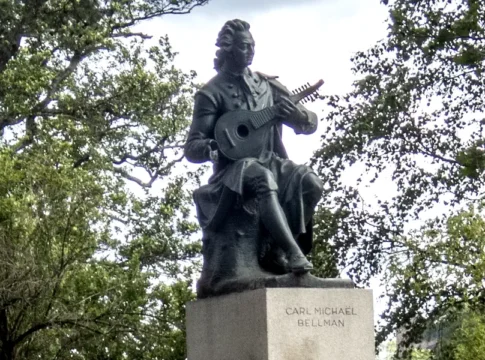 Photo: I99pema (CC BY-SA 4.0)
Photo: I99pema (CC BY-SA 4.0)Bellman’s Stockholm: Songs, Streets, and Legacy
Explore the enchanting world of Bellman's Stockholm, where timeless songs echo through historic streets, preserving his enduring legacy.

When visiting Stockholm, a city rich in history and culture, the story of Oscar II offers a fascinating glimpse into the end of Sweden’s age of royal political power. Reigning from 1872 to 1907, Oscar II guided the nation through an era of reform, diplomacy, and cultural flourishing—leaving a legacy that still echoes through Stockholm’s landmarks.
Oscar Fredrik was born in Stockholm on January 21, 1829, the third son of King Oscar I and Queen Josephine. Gifted in languages and sciences, he pursued a naval career that honed the leadership skills he would later bring to the throne. Following the death of his brother, King Karl XV, Oscar ascended as King of Sweden and Norway in 1872.






Oscar II’s reign coincided with sweeping political changes across Scandinavia. While initially cautious about rapid democratic reform, he gradually recognized the need for broader political participation.
Suffrage and reform: His stance on democracy evolved from wary conservatism to reluctant acceptance, as parliamentary power expanded and the monarchy’s direct influence declined. Though resistant at first, his role became one of guiding Sweden through a controlled, peaceful transition toward modern constitutional governance.
Oscar II’s intellectual curiosity made him a strong advocate for cultural and scientific progress.
Arts and architecture: He supported major public projects, including Stockholm’s Royal Opera House, and encouraged artists and architects who helped define a distinctly Scandinavian identity at the turn of the century.
Science and literature: A member of the Swedish Academy, Oscar II was fascinated by history, archaeology, and the natural sciences. He actively supported writers, historians, and scholars, cementing his reputation as a cultured and scholarly king.
Oscar II was admired for his diplomatic skill and often acted as mediator in international conflicts. His efforts helped Sweden and Norway avoid turmoil during tense political moments, and his reputation as a peacemaker elevated Sweden’s role in European affairs.
The defining event of his reign came in 1905, with the peaceful dissolution of the Swedish–Norwegian union. In place since 1814, the union had become strained by cultural and political differences. Despite his desire to preserve unity, Oscar II ultimately accepted Norway’s independence—marking the end of an era and cementing his legacy as a monarch who prioritized diplomacy over conflict.
Oscar II’s reign marked the twilight of royal political authority in Sweden. He is remembered not only for overseeing the dissolution of the union but also for championing culture, science, and international peace. His reign bridged tradition and modernity, steering Sweden into the 20th century with a strengthened sense of national identity.
For visitors to Stockholm, Oscar II’s influence can still be explored across the city: – The Royal Palace showcases his role in the monarchy’s history. – The Nordic Museum and Swedish History Museum display artifacts and stories from his era. – Oscar’s Church and Sofia Church symbolically connect to his reign through their names, honoring the royal family.
Exploring these sites brings to life the final chapter of Sweden’s politically powerful monarchy—offering visitors a chance to connect with a time of profound transformation.
[amazon_ads store=”sthlmmm-20″ asin1=”B0BP5LXGG1″ img1=”https://m.media-amazon.com/images/I/81-EGep2+OL
.SL1500.jpg” title1=”King Oscar Finest Norwegian Brisling Sardines in Olive Oil” asin2=”B07CG8QDHQ” img2=”https://m.media-amazon.com/images/I/61p7No8fkiL
.AC_SL1000.jpg” title2=”Oscar II Of Sweden With His Wife Princess Sophia Wilhelmina On Their 50Th Wedding Anniversary 1907″]
![]() Oscar II
Oscar II
![]() Oscar II
Oscar II